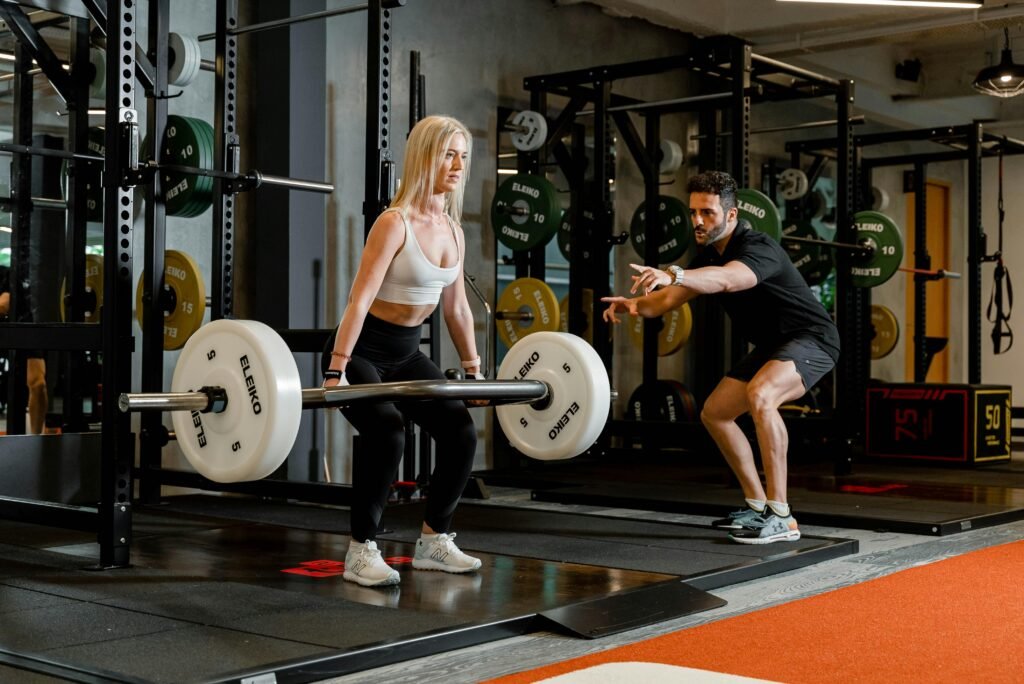Unlocking the Secrets of Advanced Bodyweight Training
Are you tired of the same old workout routine? Do you want to take your fitness to the next level? Look no further! In this article, we will unveil the secrets of advanced bodyweight training, giving you the tools to transform your body and achieve incredible strength without ever stepping foot in a gym. Get ready to unlock the hidden potential of your body as we take you on an exciting journey of discovery. Whether you are a fitness enthusiast or a beginner, prepare to be amazed as we reveal the power of bodyweight exercises that will challenge and sculpt your muscles like never before. Get ready to unleash the beast within and embark on an extraordinary adventure towards your fitness goals!

This image is property of images.pexels.com.
Benefits of Advanced Bodyweight Training
Improved strength and power
One of the major benefits of advanced bodyweight training is the significant improvement in strength and power that it can provide. Bodyweight exercises such as push-ups, pull-ups, and squats engage multiple muscle groups at once, resulting in increased overall strength. As you progress in your training and are able to perform more challenging variations of these exercises, your muscles adapt and become stronger. This improved strength not only allows you to perform everyday activities with ease but also enhances your performance in other sports and activities.
Increased mobility and flexibility
Advanced bodyweight training also promotes increased mobility and flexibility throughout the body. Many bodyweight exercises require a wide range of motion, such as deep squats or full push-ups. By regularly practicing these exercises, you can improve your joint mobility and flexibility. This added flexibility can not only prevent injuries but also enhance your overall athletic performance by allowing you to move more freely and efficiently.
Enhanced coordination and balance
Another benefit of advanced bodyweight training is the improvement in coordination and balance that it offers. Bodyweight exercises often require a high level of body control and stability, forcing your muscles to work together in a coordinated manner. As you progress in your training and tackle more challenging exercises, your coordination and balance will improve as your body becomes more accustomed to the movements. This enhanced coordination and balance can have a positive impact on your daily life, as well as in activities that require agility, such as sports and dance.
Key Principles of Advanced Bodyweight Training
Progressive overload
Progressive overload is a key principle in advanced bodyweight training. It involves gradually increasing the demands placed on your muscles to continuously challenge them and promote strength and muscle growth. You can achieve progressive overload by increasing the number of repetitions, adding complexity or variations to the exercises, or using additional equipment. By consistently pushing your body to adapt to new challenges, you can continue to make progress in your bodyweight training journey.
Compound exercises
Compound exercises are movements that engage multiple muscle groups simultaneously. These exercises are highly effective in advanced bodyweight training as they allow you to work on multiple muscle groups in one movement. Examples of compound exercises include push-ups, pull-ups, and squats. By incorporating compound exercises into your routine, you can efficiently target multiple muscle groups, save time, and maximize your training efficiency.
Isolation exercises
While compound exercises are important in advanced bodyweight training, isolation exercises also have their place. Isolation exercises involve targeting specific muscle groups to build strength and muscle definition. Examples of isolation exercises include bicep curls, tricep dips, and glute bridges. By incorporating isolation exercises into your routine, you can ensure that each muscle group receives adequate attention and development.

This image is property of images.pexels.com.
Choosing the Right Exercises
Assessing your current fitness level
Before diving into advanced bodyweight training, it’s important to assess your current fitness level. This will allow you to choose exercises that are appropriate for your abilities and help you progress safely and effectively. Assess your strength, flexibility, and balance to determine where you stand and identify any areas that may need improvement. Consulting with a fitness professional can also be helpful in creating a personalized plan that suits your specific needs and goals.
Identifying your goals
To choose the right exercises for your advanced bodyweight training program, it’s crucial to identify your goals. Do you want to build overall strength and power? Focus on specific muscle groups? Improve your mobility? Once you have a clear understanding of your goals, you can select exercises that target the areas you want to work on. Whether you’re looking to become more proficient in a specific skill or simply improve your overall fitness, having goals in mind will guide your exercise selection.
Targeting specific muscle groups
Advanced bodyweight training allows you to target specific muscle groups to achieve your desired results. Depending on your goals, you can choose exercises that focus on the upper body, lower body, or core. Push-ups, pull-ups, and dips are excellent choices for strengthening the upper body, while squats and lunges target the lower body. Planks and leg raises are effective for developing core strength. By incorporating a variety of exercises that target different muscle groups, you can ensure a well-rounded and balanced training program.
Progressing in Advanced Bodyweight Training
Increasing repetitions
One way to progress in advanced bodyweight training is by increasing the number of repetitions performed for each exercise. As your muscles adapt and become stronger, you will be able to perform more repetitions with ease. Gradually increase the number of repetitions over time, challenging yourself to push beyond your comfort zone. This progressive increase in repetitions will continue to challenge your muscles and promote further growth and strength development.
Adding complexity or variations
Adding complexity or variations to your bodyweight exercises is another way to progress in advanced bodyweight training. For example, you can increase the difficulty of a push-up by elevating your feet or performing one-arm push-ups. Similarly, you can make squats more challenging by adding jumps or performing pistol squats. These variations require more strength, balance, and coordination, pushing your body to adapt and continue making progress.
Using additional equipment
To further progress in advanced bodyweight training, you can incorporate additional equipment into your workouts. Resistance bands, exercise balls, and gymnastic rings are just a few examples of equipment that can add an extra challenge to your bodyweight exercises. By utilizing these tools, you can increase the resistance and intensity of your workouts, forcing your muscles to work harder and continue to grow and develop.

This image is property of images.pexels.com.
Common Mistakes to Avoid
Neglecting proper form and technique
One of the most common mistakes people make in advanced bodyweight training is neglecting proper form and technique. It’s essential to prioritize good form and technique in order to avoid injuries and ensure optimal muscle engagement. Take the time to learn the correct form for each exercise and focus on maintaining it throughout your training. Avoid rushing through the movements and prioritize quality over quantity. If you’re unsure about proper form, consider working with a qualified trainer or instructor to help you learn and perfect your technique.
Not following a structured program
Another common mistake is not following a structured program. Without a plan in place, it’s easy to fall into a routine that lacks progression and fails to challenge your muscles. A well-designed program will include exercises that target different muscle groups, incorporate progressive overload, and allow for rest and recovery. By following a structured program, you can ensure that you’re making steady progress and maximizing the benefits of advanced bodyweight training.
Rushing or skipping progressions
It’s important not to rush or skip progressions in advanced bodyweight training. Each exercise variation builds upon the previous one, gradually increasing the challenge and allowing your muscles to adapt appropriately. Skipping progressions or jumping to more advanced exercises too quickly can lead to injuries and hinder your progress. Take the time to master each exercise variation before moving on to more difficult ones. This patient and gradual approach will ensure that you’re building a solid foundation and progressing safely.
Creating an Effective Training Program
Setting specific goals and objectives
To create an effective training program for advanced bodyweight training, it’s crucial to set specific goals and objectives. Your goals will influence the exercises, rep ranges, and training intensity you choose. Be clear about what you want to achieve and set realistic timelines for reaching your goals. Whether you’re aiming to improve overall strength, increase muscle mass, or enhance performance in a specific sport, having specific goals will guide your training program and keep you focused.
Designing a balanced routine
A balanced routine is essential for success in advanced bodyweight training. It’s important to incorporate exercises that target all major muscle groups, including the upper body, lower body, and core. Distribute your training volume evenly across these muscle groups to ensure balanced development and reduce the risk of imbalances or overuse injuries. Additionally, include both compound and isolation exercises to maximize your training efficiency and target specific muscle groups effectively.
Incorporating rest and recovery
Rest and recovery are just as important as training when it comes to advanced bodyweight training. Giving your muscles time to recover and repair is crucial for muscle growth and overall progress. Aim to have at least one or two rest days per week and listen to your body’s cues. If you’re feeling fatigued or experiencing excessive muscle soreness, it may be a sign that you need additional rest. Proper sleep, nutrition, and hydration also play a significant role in maximizing your recovery and overall performance.
Incorporating Cardiovascular Training
Benefits of cardio for bodyweight training
Incorporating cardiovascular training into your bodyweight training program offers numerous benefits. Cardiovascular exercise improves heart health, increases lung capacity, and enhances overall endurance. When combined with the strength and power gained from advanced bodyweight training, cardiovascular fitness can improve your performance in various activities and sports. Additionally, cardio exercises help burn calories and promote weight management, making it a valuable addition to any training program.
Different types of cardio exercises
There are various types of cardio exercises that you can incorporate into your bodyweight training program. Running, cycling, swimming, and rowing are popular options for cardiovascular training. High-intensity interval training (HIIT) is another effective way to improve cardiovascular fitness while also incorporating bodyweight exercises. Experiment with different forms of cardio to find activities that you enjoy and that align with your goals and abilities.
Integrating cardio into your routine
To integrate cardio into your bodyweight training routine, consider adding cardio sessions on separate days or incorporating cardio intervals into your strength training sessions. For example, you can perform a circuit that includes bodyweight exercises with short bursts of cardio exercises such as jumping jacks or burpees. Aim for at least 150 minutes of moderate-intensity cardio or 75 minutes of vigorous-intensity cardio per week, spread out over several sessions.
Nutrition and Fueling Your Body
Importance of proper nutrition
Proper nutrition plays a vital role in advanced bodyweight training. To effectively build and maintain strength and muscle, you need to provide your body with the right nutrients. Focus on consuming a well-balanced diet that includes lean proteins, complex carbohydrates, healthy fats, and an abundance of fruits and vegetables. Adequate hydration is also essential to support your training and overall health. Prioritize whole, unprocessed foods and avoid excessive consumption of processed or sugary foods.
Macronutrient ratios for performance
In terms of macronutrient ratios, there is no one-size-fits-all approach as individual needs can vary. However, many athletes and active individuals find success with a macronutrient distribution of around 45-65% carbohydrates, 20-35% fats, and 10-35% protein. Adjust these ratios based on your specific goals and consult with a registered dietitian or sports nutritionist for personalized guidance. Experiment with different ratios and listen to your body to find what works best for you.
Pre and post-workout meal planning
Pre and post-workout nutrition is crucial for providing your body with the fuel it needs to perform and recover optimally. Before a workout, aim to consume a balanced meal or snack that includes carbohydrates for energy and some protein for muscle repair and growth. Choose easily digestible foods to avoid discomfort during your workout. After a workout, prioritize protein intake to aid in muscle recovery and consume a combination of carbohydrates and protein to replenish glycogen stores and support muscle repair.
Avoiding Plateaus in Advanced Bodyweight Training
Periodizing your training
Periodization is a key strategy to avoid plateaus in advanced bodyweight training. It involves breaking down your training into different phases or cycles, each focusing on specific goals and training stimuli. By periodically changing the intensity, volume, and exercise selection in your routine, you can continually challenge your muscles and prevent adaptation plateaus. This approach allows you to make consistent progress and overcome sticking points in your training.
Integrating new exercises and techniques
Another effective way to avoid plateaus is by integrating new exercises and techniques into your routine. Exploring different variations of bodyweight exercises or trying novel movements can stimulate new muscle fibers and prevent your body from reaching a plateau. Additionally, incorporating new training techniques such as supersets, drop sets, or eccentric-focused exercises can provide a fresh stimulus for your muscles, promoting new gains in strength and muscle development.
Listening to your body’s cues
Listening to your body’s cues is essential in avoiding plateaus and maintaining progress in advanced bodyweight training. Pay attention to how your body feels during and after workouts. If you’re consistently feeling fatigued or experiencing lingering muscle soreness, it may be a sign that you need to adjust your training load or incorporate more rest and recovery. Conversely, if you’re feeling consistently under-stimulated, it may be time to increase the intensity or add more challenging exercises to your routine. Trust your body’s signals and make adjustments accordingly to keep progressing.
Injury Prevention and Rehabilitation
Prioritizing warm-up and cool-down exercises
To prevent injuries in advanced bodyweight training, it’s crucial to prioritize warm-up and cool-down exercises. A proper warm-up prepares your muscles, joints, and connective tissues for the demands of the workout, increasing blood flow and flexibility. Start your warm-up with dynamic movements and light cardio exercises, gradually increasing the intensity. Similarly, a cool-down helps your body recover by gradually lowering your heart rate and stretching the muscles that were worked during the workout. Include static stretching and foam rolling in your cool-down routine to promote flexibility and reduce muscle soreness.
Addressing imbalances and weaknesses
Addressing imbalances and weaknesses is essential for injury prevention and long-term success in advanced bodyweight training. Pay attention to any muscle imbalances or areas of weakness and incorporate exercises that specifically target those areas. For example, if you have weak glutes, incorporate glute activation exercises into your warm-up or isolation exercises that target the glutes into your routine. Strengthening weaker muscles and addressing imbalances will improve your overall performance and reduce the risk of injuries.
Seeking professional guidance when needed
If you’re new to advanced bodyweight training or struggling with an injury, seeking professional guidance can be beneficial. A qualified fitness professional or physical therapist can assess your movement patterns, identify any imbalances or weaknesses, and provide individualized recommendations to help you overcome challenges and prevent injuries. They can also guide you through proper exercise progression and technique, ensuring that you’re training safely and effectively.
In conclusion, advanced bodyweight training offers numerous benefits, including improved strength and power, increased mobility and flexibility, and enhanced coordination and balance. By following key principles such as progressive overload and incorporating a balanced variety of exercises, you can make steady progress in your training. Avoid common mistakes, create an effective training program, and incorporate cardiovascular training, nutrition, injury prevention, and rehabilitation strategies to maximize your results and maintain long-term success in advanced bodyweight training. Remember to always listen to your body, set specific goals, and consult with professionals when needed to ensure a safe and effective training journey.



